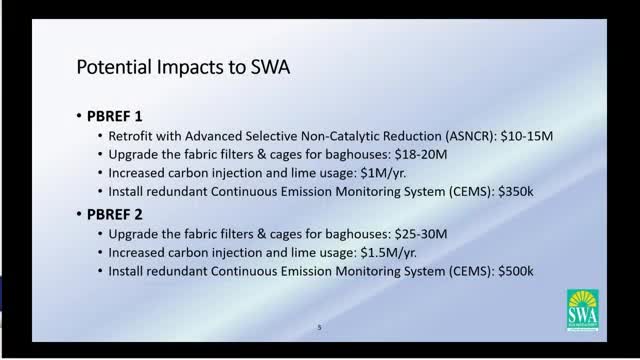Palm Beach officials discuss costly upgrades for waste energy facilities amidst new regulations
February 14, 2024 | Palm Beach County, Florida

This article was created by AI summarizing key points discussed. AI makes mistakes, so for full details and context, please refer to the video of the full meeting. Please report any errors so we can fix them. Report an error »

Palm Beach County officials are facing significant decisions regarding the future of waste management as they consider costly upgrades to their waste-to-energy facilities. During a recent meeting on February 14, 2024, discussions highlighted the need for retrofitting existing plants with advanced selective non-catalytic reduction (SNCR) technology, estimated to cost between $10 million and $15 million. This upgrade is essential to meet new emissions standards set by the Environmental Protection Agency (EPA).
The proposed changes involve enhancing the fabric filters in the baghouses, which are crucial for capturing particulate matter from flue gases. The upgrades would require new bags with smaller holes to improve particulate capture, alongside increased lime usage for controlling acid gases. These modifications are necessary to ensure compliance with stricter emissions limits, particularly for nitrogen oxides (NOx) and sulfur dioxide (SO2).
The implications of these upgrades extend beyond immediate costs. If the first facility, referred to as REF 1, were to shut down by 2029 without constructing a new facility (dubbed REF 3), the county's landfill capacity could be reduced by a decade, depleting it by 2044. This scenario would necessitate urgent decisions about waste disposal, potentially leading to trucking waste to distant landfills across Florida, which could strain resources and logistics.
The meeting also addressed environmental justice concerns raised by the community. Officials noted that waste-to-energy facilities are often located in urban areas to serve local waste disposal needs, and there is no scientific evidence linking these facilities to health risks. They emphasized that waste-to-energy plants are more environmentally friendly than landfills, as they reduce greenhouse gas emissions and recover valuable materials from waste.
As Palm Beach County navigates these complex issues, the decisions made in the coming months will have lasting impacts on waste management strategies and environmental sustainability in the region. The county is at a crossroads, balancing the need for compliance with new regulations against the financial and logistical challenges of upgrading or replacing aging waste management infrastructure.
The proposed changes involve enhancing the fabric filters in the baghouses, which are crucial for capturing particulate matter from flue gases. The upgrades would require new bags with smaller holes to improve particulate capture, alongside increased lime usage for controlling acid gases. These modifications are necessary to ensure compliance with stricter emissions limits, particularly for nitrogen oxides (NOx) and sulfur dioxide (SO2).
The implications of these upgrades extend beyond immediate costs. If the first facility, referred to as REF 1, were to shut down by 2029 without constructing a new facility (dubbed REF 3), the county's landfill capacity could be reduced by a decade, depleting it by 2044. This scenario would necessitate urgent decisions about waste disposal, potentially leading to trucking waste to distant landfills across Florida, which could strain resources and logistics.
The meeting also addressed environmental justice concerns raised by the community. Officials noted that waste-to-energy facilities are often located in urban areas to serve local waste disposal needs, and there is no scientific evidence linking these facilities to health risks. They emphasized that waste-to-energy plants are more environmentally friendly than landfills, as they reduce greenhouse gas emissions and recover valuable materials from waste.
As Palm Beach County navigates these complex issues, the decisions made in the coming months will have lasting impacts on waste management strategies and environmental sustainability in the region. The county is at a crossroads, balancing the need for compliance with new regulations against the financial and logistical challenges of upgrading or replacing aging waste management infrastructure.
View full meeting
This article is based on a recent meeting—watch the full video and explore the complete transcript for deeper insights into the discussion.
View full meeting